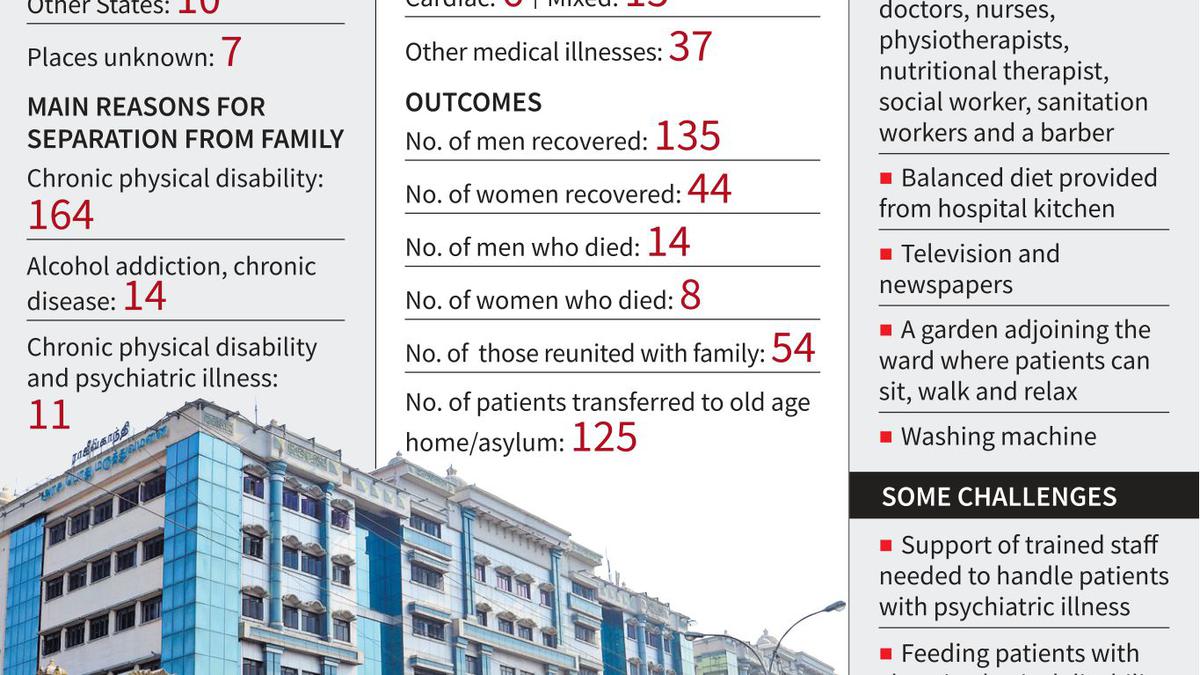
RGGGH’s rehabilitation ward shows the way in providing assistance to untended patients
The Hindu
RGGGH in Chennai has set up up an exclusive rehabilitation ward that assists untended patients
Homeless and untended patients are not uncommon in government hospitals in the State. But would a dedicated team and structured healthcare service help in their recovery and rehabilitation? Rajiv Gandhi Government General Hospital’s (RGGGH) initiative of setting up an exclusive rehabilitation ward that assisted 201 untended patients over 19 months has demonstrated its impact.
RGGGH’s experience with the rehabilitation ward was documented through a retrospective study and an article Caring for the Uncared for: A Novel Initiative of Madras Medical College (MMC) recently published in the Journal of Primary Care and Community Health. This was the first such rehabilitation ward to be set up among government hospitals in the State.
E. Theranirajan, one of the authors, and dean of MMC and RGGGH, elaborated on how the initiative started: “In 2020, during a hospital round, I found a number of persons lying on the corridors of the premises. Some of them said they were getting outpatient treatment for various illnesses but did not have a place to go and were staying within the hospital premises. They sought alms and had food from the Amma canteen. There were at least 40 of them then, and we decided to start a separate ward for them,” he said. Patients admitted to the rehabilitation ward come from different sources — admitted in different wards and abandoned by family, spotted and brought in by Good Samaritans from pavements and streets, brought in by police and social activists. During admission, they are examined at the casualty department and those requiring surgical intervention are referred to the respective speciality departments immediately. They are transferred to the rehabilitation ward on completion of initial intensive specialised treatment.
Researchers of the Multidisciplinary Research Unit, MMC, pulled out data from the medical records to take a closer look at the sociodemographic, clinical characteristics and outcomes of the untended patients admitted to the ward from December 2020 to June 2022.
Of the 201 patients (149 men and 52 women) admitted to the ward, 155 (77.1%) were aged above 50. Most patients required a longer period of admission with a median stay of 50 days. Six patients stayed for more than 300 days.
A majority of them — 80 (39.8%) — were at the orthopaedic department, 43 (21.4%) had neurological illness and 37 had general medical complications. The researchers saw that severe malnutrition was identified in 42 patients at the time of admission. Fifty four patients underwent surgery. Altered sensorium was noted in 23 patients at the time of admission, the study said. While a majority of them were managed medically, some underwent procedures and surgeries such as arthroplasty, foot amputation, split skin grafting and haemodialysis. The study, on looking at the outcomes, found that a majority of the patients — 89.1% — made a gradual recovery/improvement in their physical illness and cognitive impairment. In fact, of those who recovered, 54 were reunited with their families and 125 were sent to old age homes/asylums. Twenty-two patients died, with myocardial infarction and septicaemia being the leading causes for mortality.
“Such wards are coming up in more government hospitals. Uncared and untended persons should definitely be taken care of. When they are provided with comprehensive care, including psychological support, their condition and sense of well-being definitely improves,” Dr. Theranirajan said.













